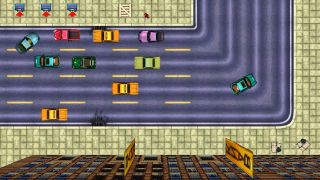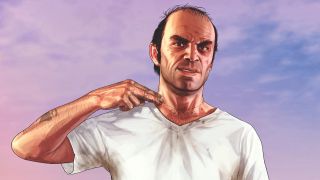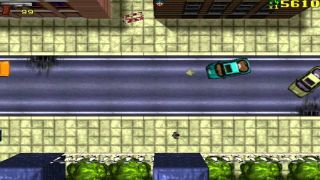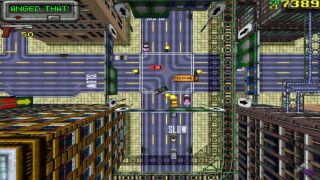The making of Grand Theft Auto - From Race 'n' Chase to GTA
In celebration of Grand Theft Auto's 20th anniversary, this making-of series explores the turbulent origins of the multi-million dollar franchise.
Part Two - Cops or robbers

Once a firm idea was in place and pitched to publisher BMG Interactive, work began on Race 'n' Chase (the early name for Grand Theft Auto) straight away, putting flesh on the living city's bare skeleton. "We went a little overboard on the simulation," says developer DMA's studio boss Dave Jones. "Buses following routes, people getting on and off, traffic lights working properly, a rail network. The more we could make it a mini living world, the morefun the game became."
Unfortunately, when development began several problems with the original concept emerged."No one wanted to play the cops, so we ditched that," recalls Jones, something that he has hopefully resolved - his new studio, Real Time Worlds, is currently producing APB, an online action game where players have to make exactly that choice.

Love Grand Theft Auto? Here are 10 games like GTA to play right now
The inherent problem with the 'cops' part of this cops and robbers game was that being the good-guy all the time was hard, as anyone who tries to play the final game as a law-abiding citizen will testify. It's harder not to run people over.
DMA lyricist and PR head Brian Baglow summarises the problems: "If traffic was heavy you, as a cop, couldn't decide to drive on the sidewalk, or plough through a busy park. We couldn't let the player do that and reward them. Driving safely and sensibly to your destination - observing all road safety - was about as much fun as Sim Driving Instructor."
Changes on this scale were typical of the entire game's development. Although it was very collaborative it could also be extremely fluid, and occasionally contentious, as Baglow remembers: "I sat through heated design meetings, which resulted in tears. Screaming, punches and arguments were common.

"We didn't have a clear concept of exactly what the final game would be like. We knew we had some great mechanics in there and some really innovative new ways to interact, but the details were impossible to pin down until you had most of the other elements in the game. Once you knew how the cars would handle and how the pedestrians would react, and so on, you could incorporate that into level design and bonuses."
Elements of the game were added as they were thought of, often as a consequence of some casual tinkering with the behavior of the living city. "The Gouranga bonus is a really good example of that," he points out. "One of the programmers came up with a routine that had pedestrians following each other. This led to the idea of a line of Krishnas following each other down the street and then, once we had all experimented with ploughing through them all in one go, the Gouranga bonus became an obvious addition."
Sign up to the GamesRadar+ Newsletter
Weekly digests, tales from the communities you love, and more
This was to be only one of the more minor changes during the development. Several, although essential to making the game a success, would cause a lot of work to be thrown away, as programmer Brian Baird recalls: "If we'd stuck to the original design, GTA would have flopped.
The scale of the missions was very small, with the design being a series of short, sharp five-minute missions, returning to a mission select screen in between. Originally the player started as a delivery boy and worked his way up to the top. We quickly found it wasn't fun delivering pizzas."

One of the defining moments of the series happened in early 1996, not long after Baird joined the team. "At that time, we were still a series of small missions," he says. "We had a long, long brainstorming session where we picked up on an idea for one long level containing multiple missions proposed by one of the level designers, Paul Farley. We took this and expanded it into the open-ended structure that the game shipped with. This meant a big expansion of the scripting and improvements to game systems - they had to handle the game running over multiple missions instead of the short structure."
"No one wanted to play the cops, so we ditched that"
Dave Jones
Many ideas and approaches were bandied about, some quite different to the final game. Baird remembers suggestions for a horror theme. "A large chunk of missions were originally planned to be Omega Man-inspired. The team loved the idea of running over hundreds of zombies but we couldn't fit it into the structure and the time it'd take wasn't worth it. Everything zombie-related got dropped."
Missions weren't the only thing he remembers having to scale back. "There were a number of background 'living breathing city' features that got dropped. The player could break traffic light boxes and a repairman would wander around fixing them. Of course the player could kill the repairmen and stop all repairs.
"There was a TV crew that went to major accidents. This got dropped, though the TV van itself stayed in. San Andreas was supposed to have a tram system like San Francisco's cable cars, working similar to the train system, however we couldn't get it working nicely with regular traffic so it was removed, though the cable art stayed in."
Head to the next page for the third and final part in this series - The road to success.
Current page: Part Two: Cops or robbers
Prev Page Part One: The perfect crime Next Page Part Three: The road to successEdge magazine was launched in 1993 with a mission to dig deep into the inner workings of the international videogame industry, quickly building a reputation for next-level analysis, features, interviews and reviews that holds fast nearly 30 years on.
Most Popular
